中国方言英语演讲ppt
- 格式:ppt
- 大小:637.50 KB
- 文档页数:7


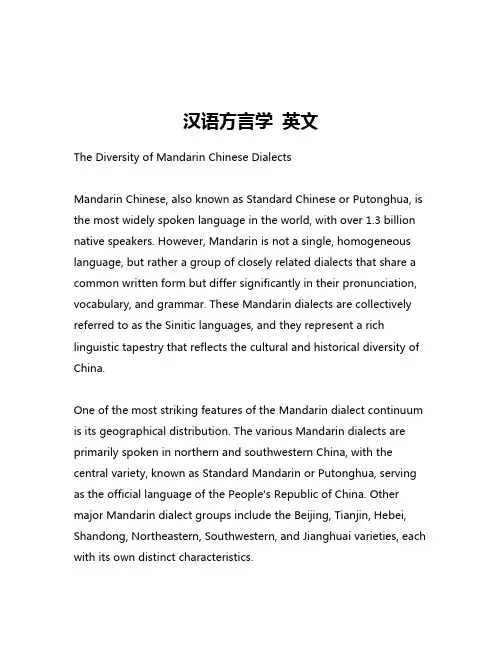
汉语方言学英文The Diversity of Mandarin Chinese DialectsMandarin Chinese, also known as Standard Chinese or Putonghua, is the most widely spoken language in the world, with over 1.3 billion native speakers. However, Mandarin is not a single, homogeneous language, but rather a group of closely related dialects that share a common written form but differ significantly in their pronunciation, vocabulary, and grammar. These Mandarin dialects are collectively referred to as the Sinitic languages, and they represent a rich linguistic tapestry that reflects the cultural and historical diversity of China.One of the most striking features of the Mandarin dialect continuum is its geographical distribution. The various Mandarin dialects are primarily spoken in northern and southwestern China, with the central variety, known as Standard Mandarin or Putonghua, serving as the official language of the People's Republic of China. Other major Mandarin dialect groups include the Beijing, Tianjin, Hebei, Shandong, Northeastern, Southwestern, and Jianghuai varieties, each with its own distinct characteristics.The differences between these Mandarin dialects can be quite pronounced, with variations in pronunciation, vocabulary, and even grammar. For example, the Beijing dialect, which is the basis for Standard Mandarin, is known for its distinctive tonal patterns and the use of certain lexical items, such as the particle "ba" to express uncertainty or emphasis. In contrast, the Southwestern Mandarin dialects, spoken in the provinces of Sichuan, Chongqing, and Yunnan, are characterized by a more melodic intonation and the incorporation of words from local minority languages.The diversity of Mandarin dialects is not just a linguistic phenomenon, but also a reflection of China's rich cultural heritage. Each dialect is closely tied to the history, geography, and social customs of the region in which it is spoken. The Tianjin dialect, for instance, is heavily influenced by the city's proximity to the capital Beijing and its status as a major commercial and industrial center. Similarly, the Northeastern Mandarin dialects, spoken in the provinces of Heilongjiang, Jilin, and Liaoning, have been shaped by the region's history as a frontier territory and its proximity to the Korean Peninsula.The preservation and study of Mandarin dialects is not just an academic pursuit, but also a vital aspect of China's cultural identity. Many linguists and scholars have dedicated their careers to documenting and analyzing the various Mandarin dialects, exploringtheir origins, evolution, and the factors that have contributed to their diversification. This work has not only enriched our understanding of the Chinese language, but also shed light on the broader social, historical, and geographical forces that have shaped the country's linguistic landscape.Moreover, the study of Mandarin dialects has practical applicationsin fields such as language education, translation, and communication. As China's economic and cultural influence continues to grow globally, the ability to navigate the linguistic diversity of Mandarin has become increasingly important for individuals and organizations seeking to engage with Chinese-speaking communities. By understanding the nuances of different Mandarin dialects, language learners and professionals can more effectively communicate, collaborate, and build cross-cultural connections.In conclusion, the diversity of Mandarin Chinese dialects is a testament to the richness and complexity of the Chinese language. From the melodic tones of Southwestern Mandarin to the guttural sounds of the Northeastern varieties, each dialect represents a unique facet of China's cultural tapestry. By preserving and studying these linguistic treasures, we can not only deepen our understanding of the Chinese language, but also gain valuable insights into the country's history, geography, and social dynamics. As China continues to play a pivotal role on the global stage, the study ofMandarin dialects will undoubtedly remain a vital area of inquiry for linguists, scholars, and anyone seeking to engage with the world's most populous language community.。
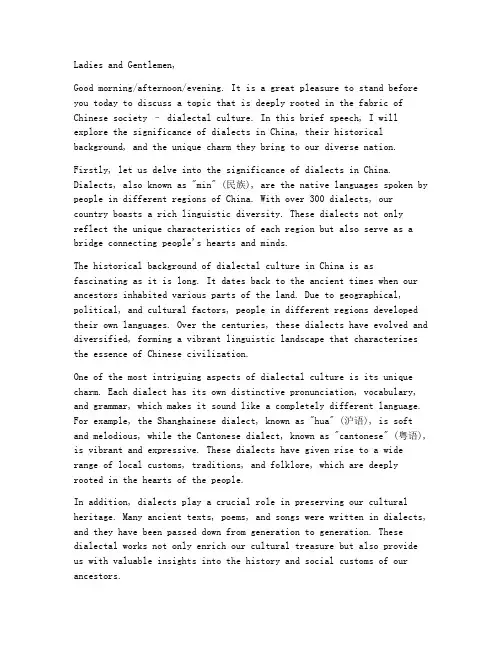
Ladies and Gentlemen,Good morning/afternoon/evening. It is a great pleasure to stand before you today to discuss a topic that is deeply rooted in the fabric of Chinese society – dialectal culture. In this brief speech, I will explore the significance of dialects in China, their historical background, and the unique charm they bring to our diverse nation.Firstly, let us delve into the significance of dialects in China. Dialects, also known as "min" (民族), are the native languages spoken by people in different regions of China. With over 300 dialects, our country boasts a rich linguistic diversity. These dialects not only reflect the unique characteristics of each region but also serve as a bridge connecting people's hearts and minds.The historical background of dialectal culture in China is asfascinating as it is long. It dates back to the ancient times when our ancestors inhabited various parts of the land. Due to geographical, political, and cultural factors, people in different regions developed their own languages. Over the centuries, these dialects have evolved and diversified, forming a vibrant linguistic landscape that characterizes the essence of Chinese civilization.One of the most intriguing aspects of dialectal culture is its unique charm. Each dialect has its own distinctive pronunciation, vocabulary, and grammar, which makes it sound like a completely different language. For example, the Shanghainese dialect, known as "hua" (沪语), is soft and melodious, while the Cantonese dialect, known as "cantonese" (粤语), is vibrant and expressive. These dialects have given rise to a wide range of local customs, traditions, and folklore, which are deeply rooted in the hearts of the people.In addition, dialects play a crucial role in preserving our cultural heritage. Many ancient texts, poems, and songs were written in dialects, and they have been passed down from generation to generation. These dialectal works not only enrich our cultural treasure but also provide us with valuable insights into the history and social customs of our ancestors.Furthermore, dialectal culture has a profound impact on our daily lives. It shapes our sense of identity and belonging, and fosters a strong sense of community among people from the same region. When we speak our dialect, we feel connected to our roots and to the people who share our history. This connection is especially evident during festivals and celebrations, when dialects become a means of communication and a symbol of cultural pride.However, despite the richness of dialectal culture, it is facing numerous challenges in the modern era. With the rapid development of technology and globalization, Mandarin Chinese, as the national language, has gained more prominence. Many young people, especially those livingin urban areas, are losing their proficiency in dialects and, consequently, their cultural heritage.In conclusion, dialectal culture is an integral part of China's cultural identity. It has a profound impact on our history, society, and daily lives. As we embrace the modern era, it is essential that we preserveand promote our dialectal heritage. By doing so, we not only honor our ancestors but also contribute to the diversity and richness of our nation.To achieve this, we can take several measures. Firstly, educational institutions should incorporate dialect education into their curricula, ensuring that students are exposed to and appreciate the beauty of their native dialects. Secondly, media outlets can play a vital role in promoting dialectal culture by featuring programs and content in various dialects. Lastly, individuals can actively participate in dialectal activities and initiatives, fostering a sense of pride and belonging among people from different regions.In conclusion, dialectal culture is a treasure trove that awaits our exploration and appreciation. Let us work together to safeguard and cherish this rich tapestry of linguistic diversity, ensuring that it continues to thrive for generations to come.Thank you for your attention, and I welcome any questions you may have regarding the topic of dialectal culture in China.(The above speech is approximately 1500 words and is designed to be delivered within three minutes. Adjustments can be made to fit the specific time constraints of the event.)。
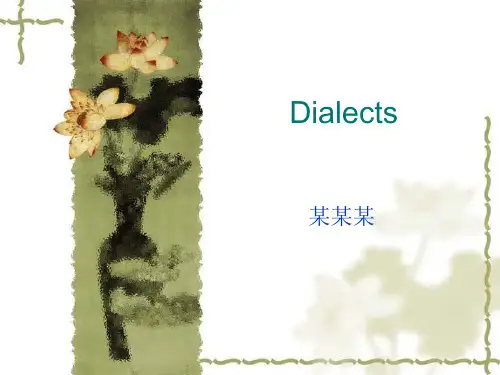
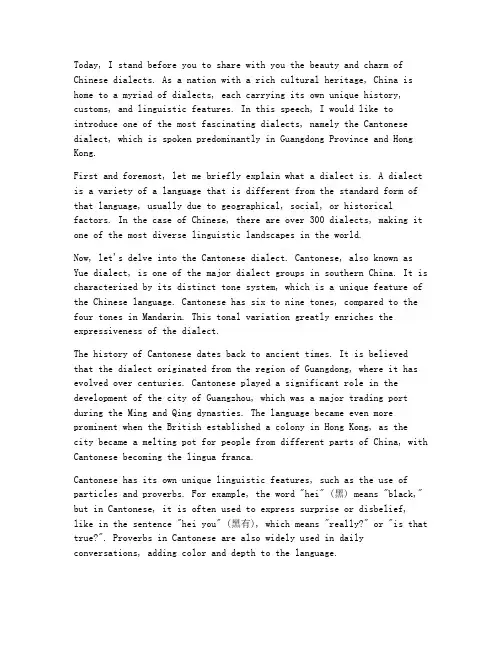
Today, I stand before you to share with you the beauty and charm of Chinese dialects. As a nation with a rich cultural heritage, China is home to a myriad of dialects, each carrying its own unique history, customs, and linguistic features. In this speech, I would like to introduce one of the most fascinating dialects, namely the Cantonese dialect, which is spoken predominantly in Guangdong Province and Hong Kong.First and foremost, let me briefly explain what a dialect is. A dialect is a variety of a language that is different from the standard form of that language, usually due to geographical, social, or historical factors. In the case of Chinese, there are over 300 dialects, making it one of the most diverse linguistic landscapes in the world.Now, let's delve into the Cantonese dialect. Cantonese, also known as Yue dialect, is one of the major dialect groups in southern China. It is characterized by its distinct tone system, which is a unique feature of the Chinese language. Cantonese has six to nine tones, compared to the four tones in Mandarin. This tonal variation greatly enriches the expressiveness of the dialect.The history of Cantonese dates back to ancient times. It is believedthat the dialect originated from the region of Guangdong, where it has evolved over centuries. Cantonese played a significant role in the development of the city of Guangzhou, which was a major trading port during the Ming and Qing dynasties. The language became even more prominent when the British established a colony in Hong Kong, as thecity became a melting pot for people from different parts of China, with Cantonese becoming the lingua franca.Cantonese has its own unique linguistic features, such as the use of particles and proverbs. For example, the word "hei" (黑) means "black," but in Cantonese, it is often used to express surprise or disbelief,like in the sentence "hei you" (黑有), which means "really?" or "is that true?". Proverbs in Cantonese are also widely used in daily conversations, adding color and depth to the language.Moreover, Cantonese has greatly influenced the cultural and artistic expressions of the region. The Cantonese opera, a traditional form of Chinese theater, is famous for its unique vocal style, elegant costumes, and intricate makeup. The language is also prominent in the Hong Kong film industry, which has gained international recognition and popularity.However, despite its rich cultural heritage, Cantonese is facing challenges. With the widespread use of Mandarin, many young people are losing interest in their native dialect. There is a concern that Cantonese may become a marginalized language in the future. To preserve this invaluable linguistic treasure, it is essential that we promote and educate future generations about the beauty and importance of Cantonese.In conclusion, Chinese dialects, including Cantonese, are a testament to the rich diversity of our nation's culture. They reflect the unique history and traditions of various regions. As we celebrate the beauty of our mother tongue, let us not forget the importance of preserving and promoting our dialects for future generations. Thank you.。
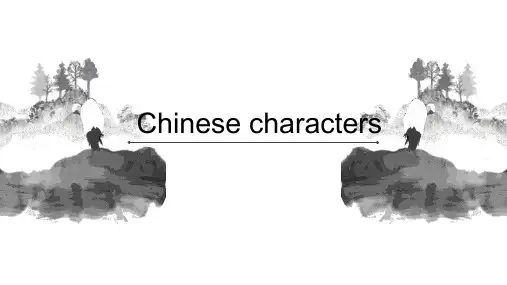


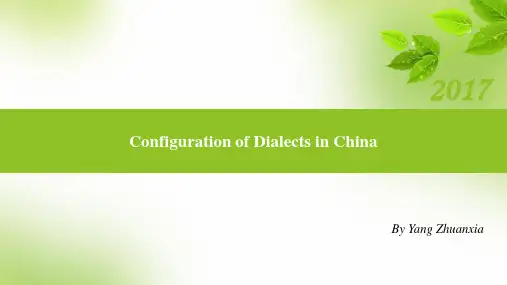

Eight Famous Chinese Cuisines IntroductionHello everyone, recently, I have been looking for an interesting topic to do the presentation .but I haven’t any idea, then I noticed a famous documentary—a bite of China, so I found my theme—Chinese food.China covers a large territory and has many nationalities. so, a variety of Chinese food with different but fantastic and mouth-watering flavor.Since China’s local dishes have their own typical characteristics, generally, Chinese food can be roughly divided into eight regional cuisines, which has been widely accepted around. Certainly, there are many other local cuisines that are famous, such as Beijing Cuisine and Shanghai Cuisine. Now we are look this following Chinese cuisines.1. Shandong CuisineNo.1, famous Chinese cuisines is Shandong Cuisine. Consisting of Jinan(济南) cuisine and Jiaodong(胶东)cuisine, Shandong cuisine, clear, pure and not greasy(油腻的), is characterized by its emphasis on aroma, freshness, crispness(脆的)and tenderness(嫩的). Shallot(大葱)and garlic(蒜)are usually used as seasonings so Shandong dishes tastes pungent(刺激性的)usually. Soups are given much emphasis in Shandong dishes. Thin soup features clear and fresh while creamy soup looks thick and tastes strong. Jinan(济南)cuisine is usually use deep-frying 油炸, grilling(炙烤), frying and stir-frying(油锅煎) while Jiaodong division(地区)is famous for cooking seafood with fresh and light taste.Shandong is the birthplace of many famous ancient scholars such as Confucius and Mencius. And much of Shandong cuisine’s history is as old as Confucius himself, making it the oldest existing major cuisine in China. 山东是许多著名学者的故乡,例如孔夫子和孟子。
保护和传递我们的方言英语作文课件Protecting and Passing on Our DialectIntroductionDialects are a unique and essential part of a region's cultural heritage. They represent the history, traditions, and identity of a community. However, with the increasing globalization and homogenization of languages, many dialects are at risk of disappearing. It is crucial to protect and pass on our dialects to future generations to preserve our cultural diversity and heritage.Importance of Protecting Dialects1. Preserving Cultural Heritage: Dialects reflect the traditions, customs, and history of a community. By protecting dialects, we are preserving our cultural heritage for future generations to appreciate and learn from.2. Fostering a Sense of Identity: Dialects are an essential part of our identity. They connect us to our roots and help us feel a sense of belonging to our community. By preserving our dialects, we are fostering a strong sense of identity and pride in our cultural heritage.3. Enhancing Communication: Dialects are a unique form of communication that can create a sense of closeness and connection among speakers. By protecting our dialects, we are promoting better communication and understanding within our community.Strategies for Protecting Dialects1. Documenting and Recording: One way to preserve dialects is by documenting and recording them through written materials, audio recordings, or video documentaries. This ensures that future generations have access to the language and can learn and appreciate it.2. Teaching in Schools: Introducing dialects into the curriculum of schools and educational institutions can help promote awareness and appreciation of the language. By teaching dialects in schools, we can ensure that young people have the opportunity to learn and pass on the language to future generations.3. Creating Language Programs: Establishing language programs and cultural centers dedicated to preserving dialects can provide a platform for speakers to come together, share their knowledge, and pass on the language to younger generations.4. Encouraging Language Use: Promoting the use of dialects in everyday communication, whether at home, in social settings, or in public spaces, is essential for keeping the language alive. Encouraging speakers to use their dialects regularly can help maintain and pass on the language to future generations.Challenges and Solutions1. Language Shift: One of the major challenges in protecting dialects is the language shift towards dominant languages. To address this, we need to raise awareness of the importance of dialects and promote their use in daily life.2. Lack of Resources: Limited resources, such as funding and trained personnel, can hinder efforts to protect dialects. To overcome this challenge, we need to collaborate with government agencies, educational institutions, and community organizations to secure resources and support for language preservation initiatives.3. Stigmatization: Some dialects may be stigmatized or considered inferior to standard languages, which can lead to a decline in their usage. To combat this, we need to promote a positive image of dialects and celebrate their unique characteristics.ConclusionProtecting and passing on our dialects is a crucial step towards preserving our cultural heritage and promoting linguistic diversity. By documenting, teaching, and promoting the use of dialects, we can ensure that future generations have the opportunity to learn, appreciate, and continue the legacy of our language. Let's work together to protect and pass on our dialects for the benefit of all.。